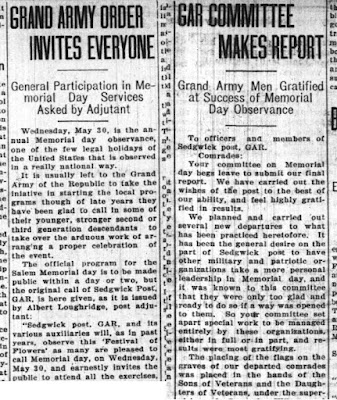The morning paper struck a new note of "patriotism" in the lead up to Memorial Day in 1923.
They advertised that "every Statesman reader should have a bright, fresh flag" for Memorial Day and hyped "Old Glory, the outward and visible sign of an inward and spiritual grace."
 |
| May 25th, 1923 |
Advertising for a new flag wasn't new, but a Christian language of sacrament for it was. An implied and lesser sacramentalism hovers around our adoration of the flag, but here it is made absolutely explicit. The phrase occurs across multiple denominations, so I am not sure it's right to ascribe it to any one particular tradition, but here is what might be its most familiar form from early America, the first American Episcopalian Book of Common Prayer, published in 1790.
 |
| Book of Common Prayer |
It's also interesting as an instance of American civic religion and something in tension with the separation of Church and State. The State isn't enforcing any particular religion, but the State here is itself the religion, and it is a kind of idolatry.
In 1923 the morning paper wasn't all that secular, however.
For the editorial, a sermon really, on Memorial Day they finished with a quote from Genesis, and by a common trope of destiny applied that verse from the Hebrew Bible to America as a way to sanctify the dead. |
| May 30th, 1923 |
All throughout the year on Sundays they reprinted an explicitly Christian editorial from the San Jose Mercury.
 |
| March 4th, 1923 |
They linked it with advertising and checked in on the debate over evolution, which would lead in a couple of years to the Scopes Trial.
 |
| June 3rd, 1923 |
It wasn't just the morning paper, though they did seem to have a stronger commitment to the religious expression.
For about a month in the fall of 1922, the afternoon paper featured weekly bible talks by a national celebrity and politician, William Jennings Bryan. It was short-lived, and the afternoon paper was generally more secular and skeptical.
 |
| October 10th, 1922 |
I can't fully situate this local expression in broader American religious history, but there was much in the air during the 1920s.
- The Scopes Trial on the teaching of evolution in 1925
- The Man Nobody Knows on Jesus as a businessman, published in 1925
- Aimee Semple McPherson starts appearing in the paper in 1926 and frequently thereafter.
The rise and popularity of the second Klan and white Christian nationalism also belongs in the mix of context. You will recall that the morning paper had drifted from skepticism to acceptance, and perhaps even embrace, of the Klan between 1921 and 1923. (Most recently see, "Mayor Giesy attends Klan Dinner in 1923.")
At the November 10th parade and rally here in 1923, Rev. V. K. Allison preached Christian nationalism:
The Ku Klux Klan is anti-nothing that is not anti-American. It strives to teach the doctrine of pure Americanism. Alien influences have grown to such extent in this country that they made necessary an organization to teach and sustain the ideals of Anglo-Saxonism. The Ku Klux Klan stands for the-principles of Protestantism and believes that the present position occupied by the United States was attained because it was a Christian nation and was Protestant.Earlier in August the Klan newspaper in Astoria, Western American, said
The Klan is the greatest of the American fraternal orders, because every member is a native-born white citizen, because it is purely American in everything, consecrated to national service under the Constitution and the flag....It is the mobilization of the best American manhood under the Fiery Cross of Christ....
The Protestant flavor and anti-Catholic bias of the Klan might cut against the high-church sacramentalism in the ad for "Old Glory," but it doesn't have to contradict it. They were into a full panoply of signs and symbols too.
 |
| May 25th and June 5th, 1923 |
Separately, preparations for the day highlighted generational transition
as Decoration Day for Civil War dead evolved into Memorial Day.
The youngest veterans of the Grand Army of the Republic would have been about 80, and the paper reported,
It is usually left to the Grand Army of the Republic to take the initiative in starting the local programs though of late years they have been glad to call in some of their younger, stronger second or third generation descendants to take over the arduous work....
A follow-up report suggests they were able to accomplish more of the transition.
Previously on Memorial Day here:
- On cars in the cemetery and some bike history, "Assessing the Load at Pioneer Cemetery" (2012)
- "Mount Crest Abbey Mausoleum turns 100 this Weekend" (2014) and "Ellis Lawrence-Designed Mausoleum Deserves Consideration this Weekend" (2013)
- "Memorial Day on the Bike Path" (2016) and "Tribute to Early Bike Committee Member Lt. Ricky Alan Serex on 1970s Sidepath" (2015)
- On the start of the transition to Memorial Day, "Decoration Day to Memorial Day: Change in 1920 under World War's Shadow" (2020)
- On the bigger observance with the Lincoln Memorial and minimizing Emancipation, "Discord in the Mystic Chords of Memory: Memorial Day 1922" (2022)


No comments:
Post a Comment